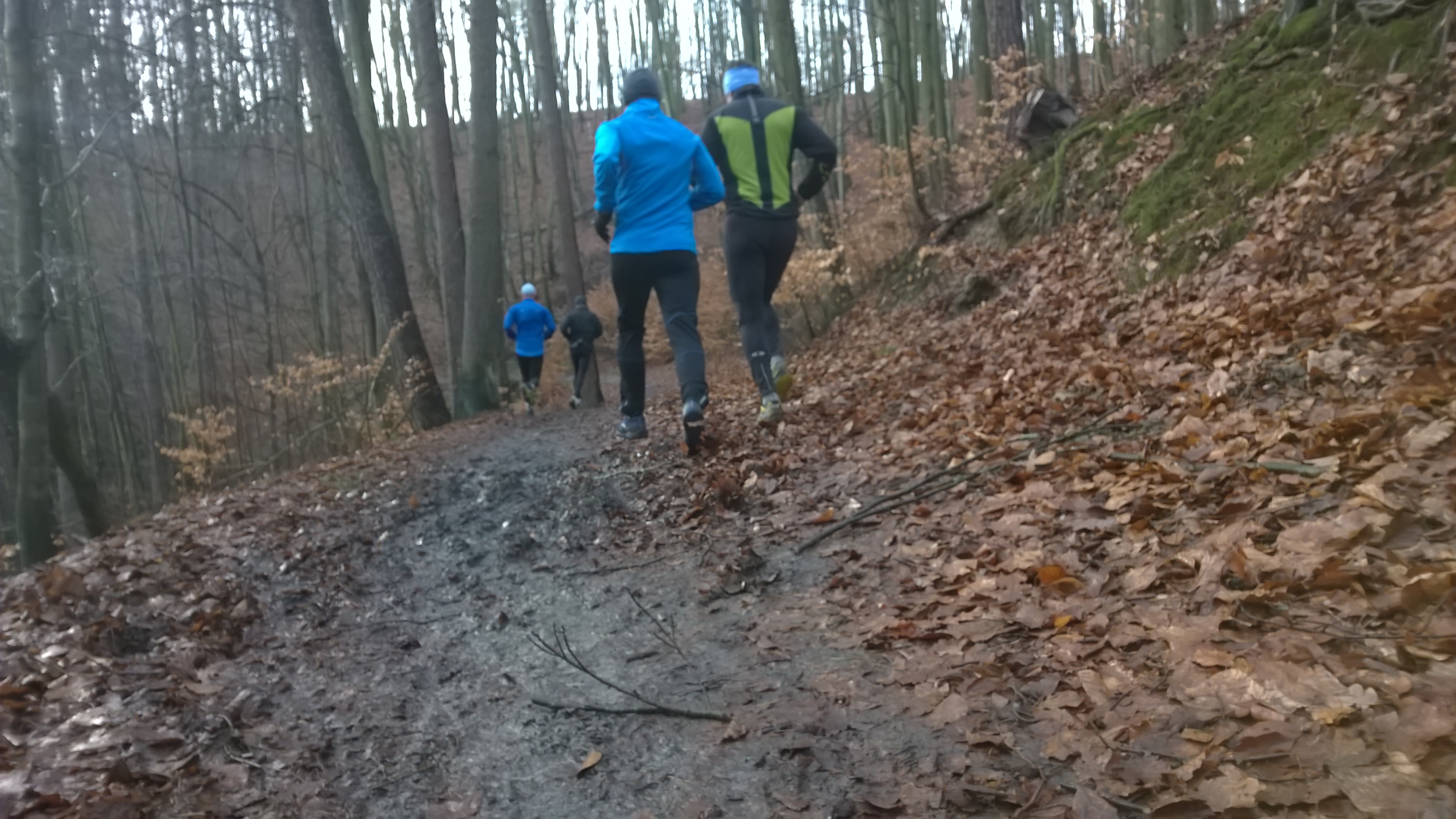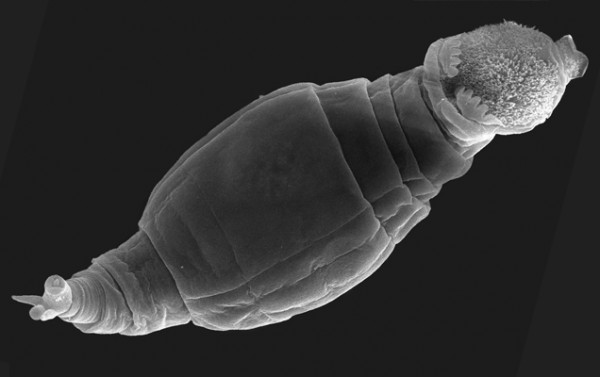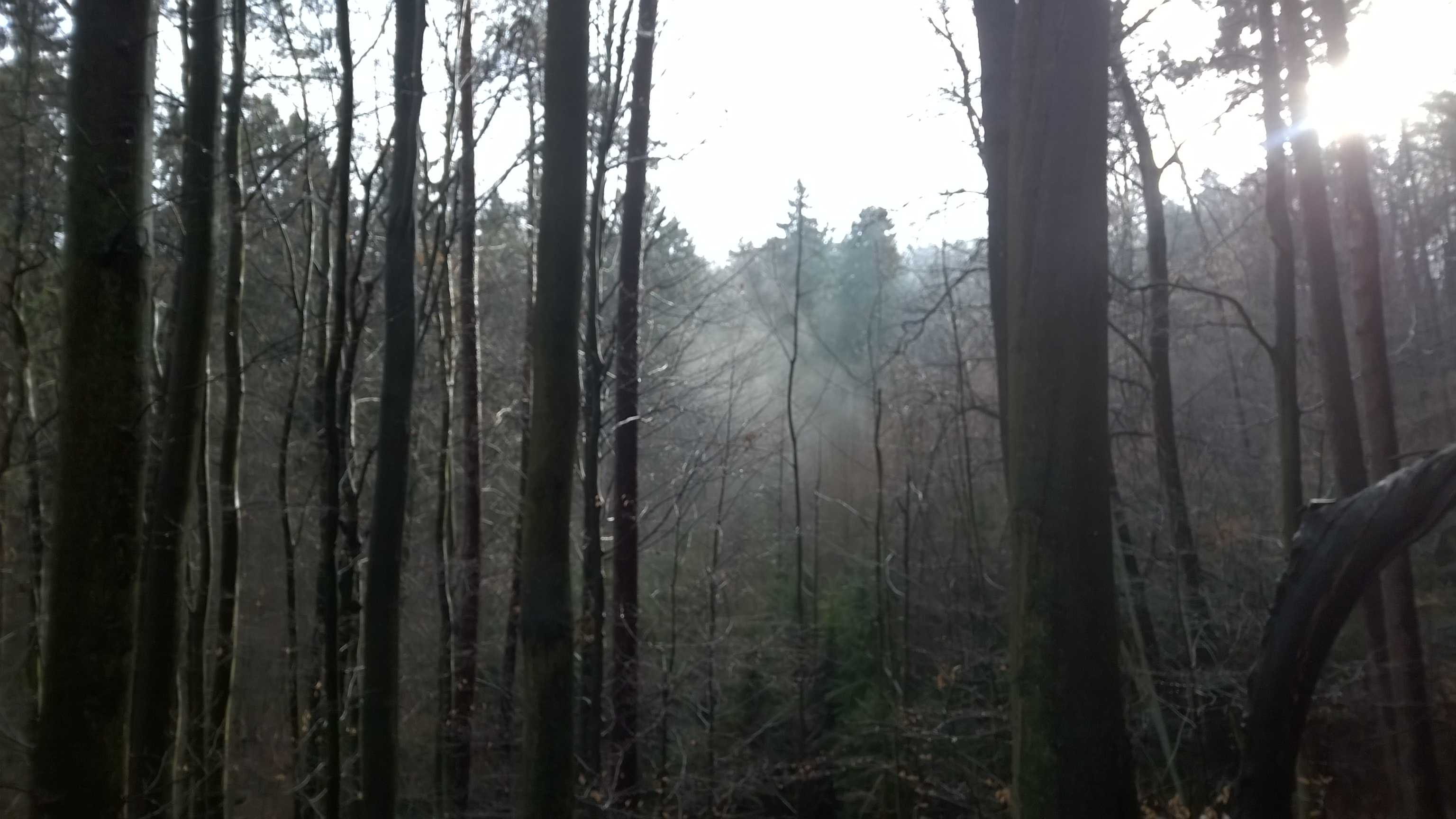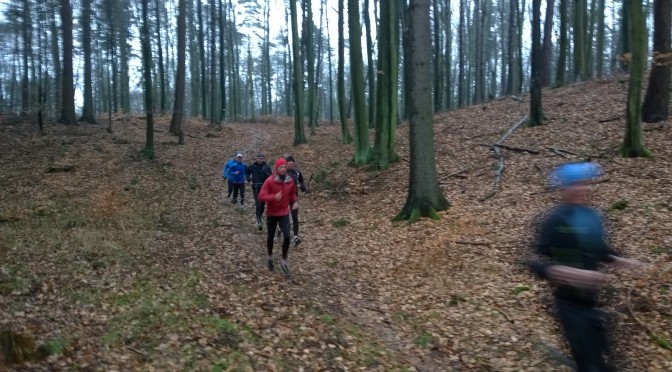Chyba jesteśmy zmęczeni. Andrzej ma dużo pracy i ciężko mu zmieścić wszystkie treningi, mnie dokucza staw skokowy, mimo tego, w ostatni weekend zaczęliśmy zwiększać zasięg – 25km w sobotę i 13km w niedzielę, a że wszystkie te biegi prowadzą w terenie (na 25km – 350m różnicy wzniesień) to można całość spokojnie porównać do ponad 40 km biegu płaskiego.
Sobota wita nas deszczem i chłodem, w zasadzie to nie chce nam się iść w tę szarugę, ale jak nie rano to kiedy? Punktualnie o 9:30, ruszamy wraz z Andrzejem w dużej grupie z Ryśkiem, Piotrem, Kubą, Przemkiem, Pawłem i … zaczynają się opowieści. Towarzyskie gadanie zawsze pomaga, ale perspektywa 2,5 godzin biegu z kulawą nogą jakoś mnie nie nastraja, więc się wlokę i staram odciążać prawą nogę, jednocześnie dobijam lewą. Windsurfingowcy opowiadają jak było na zgrupowaniach w Brazylii, w Katarze, więc czas zdecydowanie szybciej i milej upływa, choć nasze tempo nie jest nadmiernie wysokie – ok. 6min/1km, czyli 10km w godzinę. Czasami, gdy wyczynowcy opowiadają o wyścigach, tempo wzrasta do 5:30/1km, a gdy tłumaczą detale wpływające na rywalizację na poziomie najlepszej dziesiątki na świecie, tempo podskakuje do 5:10/km. To efekt psychologiczny, o którym opowiadał Wojtek Ratkowski, otóż temat rywalizacji bezwiednie podnosi tempo biegu w grupie, tylko że przed nami jeszcze ponad połowa drogi i dwa męczące podbiegi.
Zapada chwila ciszy, więc rzucam słaby żarcik, że deszcz wcale nie pada, że to tylko kondensacja pary – biegniemy dalej w milczeniu. Przed nami 13ty kilometr, a tam ukryte pod liśćmi butelki z piciem. Żeby ich nie targać zaplanowałem trasę w kształcie ósemki i na początku zostawiliśmy co trzeba w lesie. Odwodnienie powoduje spadek wydolności do 18%, a na wysokości, (2500 mnpm, badania zawodowych kolarzy) nawet do 32%. Pewnie nie jesteśmy aż tak wysuszeni, ale parę łyków wody dobrze robi i ruszamy na drugą połowę treningu, mokrzy od wewnątrz i od zewnątrz.

Deszcz jest słabszy, ale teren robi się coraz bardziej błotnisty, ciężki i śliski. Patrzę na te kałuże i przypominam sobie o cudzie natury, który je zamieszkuje. Nie czekając dłużej rozpoczynam wykład, który skutecznie odwraca uwagę części z nas od innych myśli, typu po co mi to było.

Wrotki bdelloidowe, to maleńkie, niewidoczne dla oka robaczki, które zamieszkują właśnie w zbiornikach wodnych, kałużach, miejscach wilgotnych itp., ale nie są zbyt kapryśne, wręcz odwrotnie, są mistrzami przetrwania w ekstremalnych warunkach. Zagotujesz wodę, przeżyją, zamrozisz do zera absolutnego, to wrotka też przetrwa i po rozmrożeniu wróci do swoich zadań jakby nic się nie wydarzyło. Ale fascynacja wrotkami wynika również z faktu ich wyjątkowego sposobu rozmnażania, a właściwie stosowania wszystkich sposobów i jeszcze czegoś. Płciowo, partenogenetycznie, czyli z niezapłodnionego jaja (dzieworodnie – również owady, stawonogi, niektóre jaszczurki, w tym wielki waran), co powoduje, że partnerzy nie są potrzebni, ale do czasu. Kiedy trzeba troszkę udoskonalić DNA, wówczas, panie – wrotki zaczynają potrzebować panów – wrotków. Pewnie na przestrzeni 80 mln lat ich ewolucji były z tego powodu niejedne dąsy, więc panie – wrotki wykombinowały własny patent – mogą i udoskonalają, czyli rekombinują swoje DNA w oparciu o DNA (z mitochondriów) np. grzybów, albo glonów… Szok, niedowierzanie, jesteśmy niepotrzebni! Mimo, że pod górę i jeszcze 7km to widzę, że tempo w męskiej grupie wzrasta, taaak – informacja, że wrotki bdelloidowe nawet raz na 500 lat nie zadzwonią do swoich wrotków, budzą poczucie, pewnego rodzaju smutku. Koledzy na 20 km cisną już z myślą o powrocie. Zamiast poprawić humor, wprowadziłem w nostalgiczny nastrój, ale przynajmniej przestała mnie boleć stopa. Andrzej prowokuje, że ta wisząca, piękna mgła to też rezerwuar słodkiej wody, i że te wrotki tam sobie, z nas, facetów, drwią. Patrzę i zatrzymuje się, by zrobić zdjęcie chmurce i gonię grupę.

Wyobraź sobie, że chmury i mgły to zaledwie 0,001 % zasobów słodkiej wody na ziemi, więcej jest w rzekach i jeziorach (0,007 %), sporo (30%) jest pod ziemią, ale większość zmagazynowana jest w postaci lodu i lądolodu (68%)… i oby się te zasoby zbyt szybko nie stopiły. Tak poza wszystkim to co opisałem to tylko 3% zasobów całej wody znajdującej się na naszej planecie, reszta -:) – te 97% to woda słona znajdująca się w morzach i oceanach, której nie możemy pić, bo padlibyśmy z odwodnienia. Ostatnie słowa na 25km biegu, po 2godz 33min, tworzą synergie ze stanem naszych ciał, również nie krzepią … Kończymy szybko trening rozciąganiem i cichym postanowieniem, że jeszcze dzisiaj odgonimy czarne myśli nt. przydatności rodzaju męskiego dobrym winem – tak będzie bezpieczniej
Translation Anna Meysztowicz :
shock at 18 km – bdelloid rotifers
I think we are tired. Andrzej has a lot of work and it’s difficult for him to fit in all the training sessions. I am having problems with my ankle yet, regardless of all this, we began to increase our distance last weekend – 25 km on Saturday and 13 km on Sunday, and since all of these runs are in rough terrain (350 m of elevations in the 25 km segment), all this can be easily compared to over 40 km of running on a flat surface. Saturday greets us cold and wet, in fact we don’t even want to go out into this dreary greyness, but if not now, then when? Punctually at 9:30 am we set off in a big group with Rysiek, Piotr, Kuba, Przemek and Paweł, and our storytelling begins. Chatting together always helps, but the perspective of a 2.5 hr run with a limp is not helping to get me in the mood, so I trod along slowly trying to keep the weight off my right leg, and simultaneously overburdening my left one. The windsurfers tell us about their experiences competing in Brazil and Qatar, so the time goes by quicker and more pleasantly, although our tempo is not very good – approx. 1 km/6 min, i.e. 10 km per hour. Sometimes, when our sportsmen are talking about races, the tempo increases to 1 km/5:30 min, and when they explain the details influencing rivalry at the level of the world’s top ten, the tempo jumps to 1 km/5:10 min. This is a psychological effect that Wojtek Ratkowski mentioned, which is that the topic of rivalry subconsciously increases tempo in a group run, except that we have over half of our run to go and two exhausting ascents. We fall silent for a while, so I throw in a lame joke that it’s not really rain that’s in the air just condensed steam – we run on in silence.
We have our 13th kilometre ahead and, hidden under the leaves there, our drink bottles. So as not to carry them, I planned our route in the shape of a figure 8 and we left what we needed at the start of our run in the forest. Dehydration leads to a fall in capacity of up to 18%, and higher up (2500 mnpm, as tested by professional bikers) even up to 32%. We are likely not too dried up but a few gulps of water does us good and we set off for the second half of our training, wet both on the inside and the outside. The rain is lighter but the road is increasingly muddy, difficult and slippery. I observe the puddles and remember what miracles of nature inhabit them. Not waiting I begin my lecture that successfully takes the attention of some of us away from other thoughts along the lines of why am I doing this?
Bdelloid rotifers are miniscule bugs, invisible to the eye, that inhabit water tanks, puddles, humid places, etc., but are not overly fussy, the opposite in fact – they are masters of survival in extreme conditions. You boil the water, they will survive, you freeze it completely, the rotifer will also survive and, after thawing, return to its activities as if nothing had happened. But what is also fascinating about the rotifers is the fact that they reproduce in such a unique way, in particular by applying all possible methods and something more. Sexually, parthenogenetic, i.e. from an unfertilised egg (virginoparous – also insects, arthropods, some lizards including the perentie (a type of goanna lizard)), which means that they don’t need partners up to a certain point. When it is necessary to perfect the DNA a little then the female rotifers begin to need male rotifers. Probably over the expanse of 80 million years of their evolution there was more than one episode of sulking, so the female rotifers came up with their own patent – they are able to and are perfecting – i.e. recombining their DNA based on DNA from mitochondria, e.g. mould or algae… Shock, incredulity, we are not needed! Despite running uphill with 7 km to go, I can see the tempo increasing in the men’s group – yeeees, the information that female bdelloid rotifers won’t telephone their male counterparts not even once in 500 years gives rise to a certain feeling of sadness. By the 20th kilometre we are pressing on with the thought of going home. Instead of cheering us up I have introduced a nostalgic mood, but at least my foot has stopped hurting. Andrzej says that the suspended beautiful mist is a reservoir of fresh water and that the rotifers are there, mocking us men.
I look and stop to photograph the cloud and chase the group. Imagine if you will that the clouds and mists comprise just 0.001% of our fresh water supply on Earth, there is more in lakes and rivers (0.007%), quite a large amount (30%) is underground, but the majority is stored in the form of ice and glaciers (68%)… and may that not melt too soon. Besides all the water I have described here makes up just 3% of all of our fresh resources on planet Earth, the rest – that 97% – is salt water found in seas and oceans that we cannot drink because we would die of dehydration. The final words on the 25th km of our run, after 2 h 33 min, create a synergy with the state of our bodies, and don’t give us strength… We finish our training quickly with a stretch and a quiet resolution that still today we will fend off the dark thoughts about the usefulness of the male species with some good wine – that will be safer.
